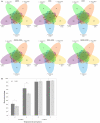The genome sequence of the North-European cucumber (Cucumis sativus L.) unravels evolutionary adaptation mechanisms in plants
- PMID: 21829493
- PMCID: PMC3145757
- DOI: 10.1371/journal.pone.0022728
The genome sequence of the North-European cucumber (Cucumis sativus L.) unravels evolutionary adaptation mechanisms in plants
Abstract
Cucumber (Cucumis sativus L.), a widely cultivated crop, has originated from Eastern Himalayas and secondary domestication regions includes highly divergent climate conditions e.g. temperate and subtropical. We wanted to uncover adaptive genome differences between the cucumber cultivars and what sort of evolutionary molecular mechanisms regulate genetic adaptation of plants to different ecosystems and organism biodiversity. Here we present the draft genome sequence of the Cucumis sativus genome of the North-European Borszczagowski cultivar (line B10) and comparative genomics studies with the known genomes of: C. sativus (Chinese cultivar--Chinese Long (line 9930)), Arabidopsis thaliana, Populus trichocarpa and Oryza sativa. Cucumber genomes show extensive chromosomal rearrangements, distinct differences in quantity of the particular genes (e.g. involved in photosynthesis, respiration, sugar metabolism, chlorophyll degradation, regulation of gene expression, photooxidative stress tolerance, higher non-optimal temperatures tolerance and ammonium ion assimilation) as well as in distributions of abscisic acid-, dehydration- and ethylene-responsive cis-regulatory elements (CREs) in promoters of orthologous group of genes, which lead to the specific adaptation features. Abscisic acid treatment of non-acclimated Arabidopsis and C. sativus seedlings induced moderate freezing tolerance in Arabidopsis but not in C. sativus. This experiment together with analysis of abscisic acid-specific CRE distributions give a clue why C. sativus is much more susceptible to moderate freezing stresses than A. thaliana. Comparative analysis of all the five genomes showed that, each species and/or cultivars has a specific profile of CRE content in promoters of orthologous genes. Our results constitute the substantial and original resource for the basic and applied research on environmental adaptations of plants, which could facilitate creation of new crops with improved growth and yield in divergent conditions.
Conflict of interest statement
Figures


Similar articles
-
Chromosome rearrangements during domestication of cucumber as revealed by high-density genetic mapping and draft genome assembly.Plant J. 2012 Sep;71(6):895-906. doi: 10.1111/j.1365-313X.2012.05017.x. Epub 2012 Jul 9. Plant J. 2012. PMID: 22487099
-
Chromosomal Locations of a Non-LTR Retrotransposon, Menolird18, in Cucumis melo and Cucumis sativus, and Its Implication on Genome Evolution of Cucumis Species.Cytogenet Genome Res. 2020;160(9):554-564. doi: 10.1159/000511119. Epub 2020 Nov 10. Cytogenet Genome Res. 2020. PMID: 33171461
-
Genome-wide identification of CLE gene family and their potential roles in bolting and fruit bearing in cucumber (Cucumis sativus L.).BMC Plant Biol. 2021 Mar 19;21(1):143. doi: 10.1186/s12870-021-02900-2. BMC Plant Biol. 2021. PMID: 33740893 Free PMC article.
-
Recent progress on the molecular breeding of Cucumis sativus L. in China.Theor Appl Genet. 2020 May;133(5):1777-1790. doi: 10.1007/s00122-019-03484-0. Epub 2019 Nov 21. Theor Appl Genet. 2020. PMID: 31754760 Review.
-
Next generation sequencing and omics in cucumber (Cucumis sativus L.) breeding directed research.Plant Sci. 2016 Jan;242:77-88. doi: 10.1016/j.plantsci.2015.07.025. Epub 2015 Jul 31. Plant Sci. 2016. PMID: 26566826 Review.
Cited by
-
Advances in genomics for flatfish aquaculture.Genes Nutr. 2013 Jan;8(1):5-17. doi: 10.1007/s12263-012-0312-8. Epub 2012 Aug 19. Genes Nutr. 2013. PMID: 22903900 Free PMC article.
-
Fine mapping of the pleiotropic locus B for black spine and orange mature fruit color in cucumber identifies a 50 kb region containing a R2R3-MYB transcription factor.Theor Appl Genet. 2013 Aug;126(8):2187-96. doi: 10.1007/s00122-013-2128-3. Epub 2013 May 21. Theor Appl Genet. 2013. PMID: 23689749
-
Mapping Cucumber Vein Yellowing Virus Resistance in Cucumber (Cucumis sativus L.) by Using BSA-seq Analysis.Front Plant Sci. 2019 Dec 3;10:1583. doi: 10.3389/fpls.2019.01583. eCollection 2019. Front Plant Sci. 2019. PMID: 31850047 Free PMC article.
-
Diploid chromosome-level reference genome and population genomic analyses provide insights into Gypenoside biosynthesis and demographic evolution of Gynostemma pentaphyllum (Cucurbitaceae).Hortic Res. 2022 Oct 19;10(1):uhac231. doi: 10.1093/hr/uhac231. eCollection 2023. Hortic Res. 2022. PMID: 36643751 Free PMC article.
-
A chromosome-scale genome assembly of cucumber (Cucumis sativus L.).Gigascience. 2019 Jun 1;8(6):giz072. doi: 10.1093/gigascience/giz072. Gigascience. 2019. PMID: 31216035 Free PMC article.
References
-
- Havey MJ. Predominant Paternal Transmission of the Mitochondrial Genome in Cucumber. J Hered. 1997;88:232–235.
-
- Ward BL, Anderson RS, Bendich AJ. The mitochondrial genome is large and variable in a family of plants (cucurbitaceae). Cell. 1981;25:793–803. - PubMed
-
- Bartoszewski G, Havey MJ, Ziółkowska A, Długosz M, Malepszy S. The selection of mosaic (MSC) phenotype after passage of cucumber (Cucumis sativus L.) through cell culture - a method to obtain plant mitochondrial mutants. J Appl Genet. 2007;48:1–9. - PubMed
-
- Malepszy S, Niemirowicz-Szczytt K. Sex determination in cucumber (Cucumis sativus) as a model system for molecular biology. Plant Sci. 1991;80:39–47.
-
- Ziółkowska A, Bartoszewski G, Burza W, Kuraś M, Pląder W, et al. Mitochondrial mutant MSC cucumber shows impaired somatic embryogenesis. Plant Cell Tissue Organ Cult. 2005;80:329–338.
Publication types
MeSH terms
Substances
Grants and funding
LinkOut - more resources
Full Text Sources
Molecular Biology Databases

